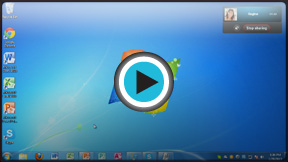
Skype
Screen Sharing and Sending Files
Sharing with your contacts on Skype
There are two additional ways to communicate with your contacts on Skype. The first is screen sharing, a feature that lets you share live video of what's on your computer screen (for example, a website, or the software you're using). It's a great way to demonstrate how to do something, or to show another person what you're working on.
The second is sending files to your contacts. This feature lets you share any size or type of file, including documents, photos, presentations, and other things you have saved to your computer.
Watch the video to learn how to share your screen and send files.
To share your screen:
- Open the Skype window and sign in.
- Make a voice call or video call to one of your contacts.
- Click the + button in the call window, then choose Share screens.
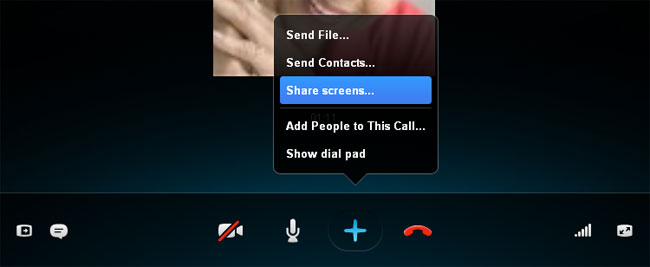 The screen sharing button
The screen sharing button - The other person will be able to see live video of what's on your screen, including your desktop and any programs that you may have open. Below is an example of what it will look like from your contact's point of view.
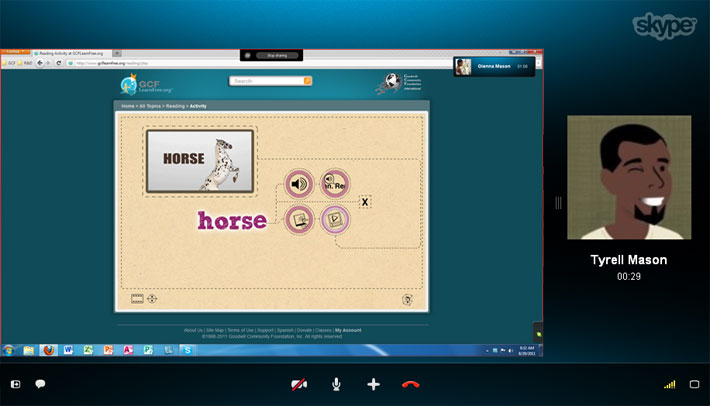 Screen sharing in action
Screen sharing in action - To stop sharing your screen, click the Stop sharing button.
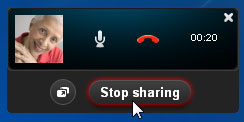 Ending the screen sharing
Ending the screen sharing - As usual, click the End Call button when you're ready to hang up.
Screen safety tips

Would you feel comfortable checking your bank account online while a coworker looked over your shoulder? Probably not. It's a good idea to think of screen sharing the same way. Basically, screen sharing lets the other person see your entire desktop, plus anything else you have open. That can include your bank account, your email—even photos or websites you don't want other people to see. To keep your information private, always follow these safety tips.
- Check your desktop before you share your screen. The other person will be able to see any files, folders, or icons you have saved there, plus the image you're using for your background. Anything you want to keep private should be changed or moved to another location.
- Close any programs you don't want the other person to see. This includes your browser and any browser tabs you may have forgotten about. If you leave that information open, you may click it by accident while you're in the middle of a session.
- Sign out of IM programs like Google Hangouts. You could also change your online status to "Busy" to let friends know you're unavailable. This way, you won't receive any unexpected IMs or share a private IM conversation by accident.
To send files on Skype:
- Open the Skype window and sign in.
- Click the person you want to send a file to on the Contacts tab.
- The contact's information will open in a pane on the right.
- Click the + button, then choose Send File.
 Sending a file
Sending a file - Select the file you want to send. You may need to navigate to where it's saved on your computer. To select multiple files, press and hold Ctrl on your keyboard while you select each file.
- Click Open.
 Choosing a file to send
Choosing a file to send - The other person will receive the file and decide whether or not to download it. If the contact is offline, he or she will receive the file after signing in.
- The sent file will appear in your history.
 Confirmation of a sent file
Confirmation of a sent file
You can also send files during a call. All you have to do is click the + button in the call window, then choose Send File.
 Sending a file during a call
Sending a file during a callTo receive files on Skype:
So what do you see when someone sends you a file on Skype? Sometimes a pop-up, but more often a notification on your computer's taskbar. It may look something like this:
To accept or reject the file, follow these steps.
- Open the Skype window.
- Go to the Recent tab or click the person who sent you the file on the Contacts tab. Both areas will be marked to let you know that you have a file waiting. (The same thing happens if you receive a file while you're offline.)
 New file in the Skype window
New file in the Skype window - The sender's information will open in a pane on the right.
- Click Save as to download the file or Cancel to reject it.
 Downloading a file
Downloading a file - A pop-up window may appear, warning you that files can contain viruses. To learn more, read our file safety tips below. Click OK to confirm that you want to download the file.
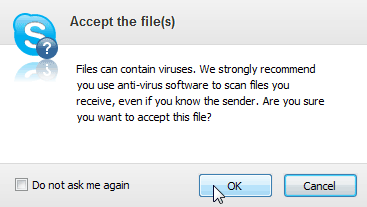 Accepting the file
Accepting the file - Choose where you want to save the file on your computer. Then click the Save button.
 Choosing where to save the file
Choosing where to save the file - The saved file will appear in your history. Click Open file to view it.
 Opening a saved file
Opening a saved file
File safety tips

As you can see, it's possible that files sent to you on Skype can contain viruses and other malware. When you save an infected file, malware can be installed on your computer automatically, without you even knowing it. Malware can damage other files, steal passwords, spy on you, and more. This is why it's important to be careful when receiving files, and to always follow these precautions:
- Don't open any files you weren't expecting. Even if the file looks like it's from someone you know, it may have been sent to you automatically by a virus. This is how many viruses spread. If a contact sends you a file that seems suspicious, you should call or IM that person to verify that it was meant for you.
- Keep your antivirus software updated. Viruses can spread quickly, and if your antivirus software isn't up-to-date it may not be able to block new viruses.
- Keep your computer's firewall on. Firewall software helps to prevent people or malware from gaining access to your computer through the Internet.
To learn more about keeping your computer safe from viruses, review our Internet Safety lesson on Protecting Your Computer from Internet Threats.
